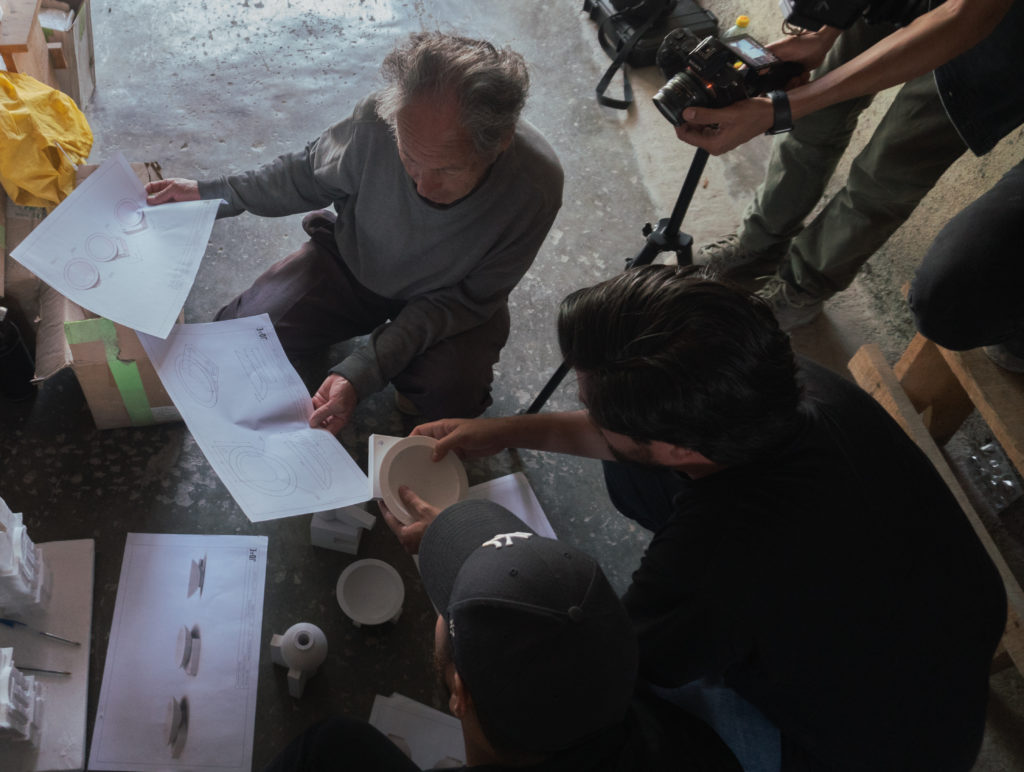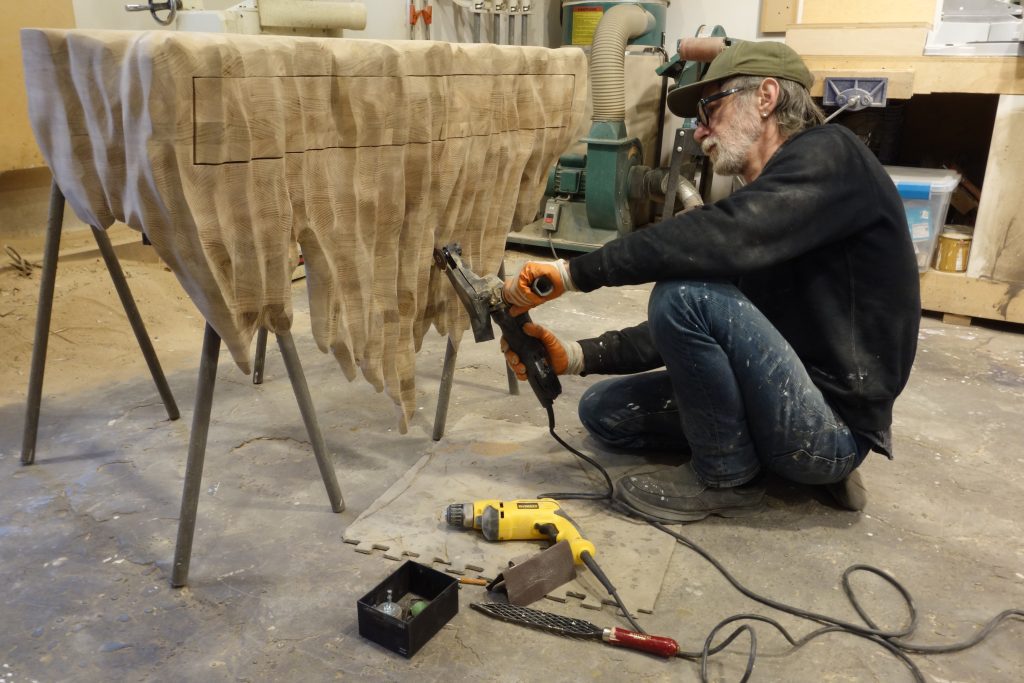

Jorge Diego Etienne: Fusing Digital Approaches with Artisanal Techniques
“We don’t design in a vacuum and we do not create objects for merely décor. Our starting point is always the people who will use it, how they will use it, and where they will use it. Beauty is, of course, important, but creating value is the most important aspect of our work, that is the impact we desire from our projects.”
– Jorge Diego Etienne
View Jorge Diego Etienne’s showroom, including “Galeana Stool”
In a country with a long and rich heritage of diverse traditions and identities, finding a unique voice can be challenging. Within the contemporary Mexican collectible design scene, designers are drawing on long-held techniques, materials, and forms to carve out their own space, while maintaining a connection and respect for those that came before them. Collaboration with local craftspeople and artisans, whose knowledge and skills are invaluable in this realm of design, is one of the ways in which makers are able to contextualise their practices and share their combined talents with the world.
Through highlighting material and form, Jorge Diego Etienne and his eponymous studio brings attention to the connection between how pieces and spaces are used and how they are created. The Monterrey-based studio was founded in 2012 following Etienne’s return to Mexico. His design experience spans the globe: from his university career at the Tec de Monterrey where he earned a Bachelors in Industrial Design, to an internship in Amsterdam with designer Khodi Feiz, to a design and craftsmanship programme in Kyoto, Japan. His globalised perspective of design and its many facets inspires his approach to product design, championing the importance of functionality in everyday life along with aesthetics.
The studio, which offers services including consultancy, creative direction, product and experience design, and trend analysis, seeks to go beyond design and create physical, emotional, and cultural connections through their work. They’ve gained the attention of local and global companies, strategically developing pieces and spaces with user experience in mind. Other projects share inherent stories, continuing cultural narratives and identities in an innovative and respectful manner. Their latest collection, “Galeana”, does just this. Designed in collaboration with Master Craftsman Francisco Charles, the collection merges artisanal craftsmanship with experimental digital modelling and 3D printing. In doing so, the collection supports the rich history of traditional techniques and local materials while re-contextualising them for the larger contemporary collectible design world.
With reference to your background in industrial design and international influences, can you describe how Jorge Diego Etienne came together as a studio?
It all started with the experience I accumulated doing courses in schools around the globe which led to meeting great people, like Khodi Feiz, who I joined in his Amsterdam Studio for an internship. It was the first time I thought that I wanted to have a studio of my own, eventually. After graduating in Mexico, I worked on my own for about a year and then left for a year-round fellowship in Japan. It was during that year that I plotted my return to Monterrey with the goal of setting up a studio.
It was very important for me to jump from doing freelance projects to a formal workspace, process, and most important, a vision of what I wanted my practice to represent and embody. As soon as I landed back from Japan, I started looking for a space, assembling a team and most important, seeking companies to start collaborating with. Luckily, my previous work had caught attention in the press, and even made it to important design exhibitions, which helped to boost my exposure on my return.
But most important, I think the studio came together when I established a way of thinking and approaching design from Mexico, to the world.
The studio’s objectives pay close attention to culture, identity, story telling, and design heritage – what is the greatest influence for you as designers from these sources?
I believe that design should create value and be coherent with its context, so culture, identity, and heritage all come into play in our work, they all inform and influence the decisions we make in our design process. At the same time, we are very careful to not fall into a trap of just re-creating them, we strive to deconstruct such elements and subtly incorporate them into contemporary objects that fit into our lifestyle. Mexico will always play a part of this, but I like to think that our work can be well appreciated beyond our country and be a part of homes everywhere in the world, but with a story worth being told.
Why is a focus on the connection between design, space, and people such an important aspect of your design philosophy? How does this focus influence the development of new pieces or spaces?
We don’t design in a vacuum and we do not create objects for merely décor. Our starting point is always the people who will use it, how they will use it, and where they will use it. Beauty is, of course, important, but creating value is the most important aspect of our work, that is the impact we desire from our projects. Through the years I’ve come to think that design is a medium to create this value in society, culture, or the industry.


“Every object is a dialogue and, for us in the studio, it was key to be receptive to how Francisco [Charles] interpreted each object to make them unique and of the highest quality in both concept and execution.”


The “Galeana” collection has been created in collaboration with master craftsman Francisco Charles and brings together artisanal techniques and digital modelling. What approach did you take to develop this project?
We started working with Master Francisco about six years ago, and I’ve always been amazed by his craft; the knowledge, passion, the precision and quality. We’ve built a great relationship with a deep understanding both ways. So, in Galeana, the objects are a combination of a discourse we wanted to project, and shapes we were interested in pursuing, with the possibilities of the material and the translation of Francisco from our digital 3D approach to his hands and how he carves each stone. Every object is a dialogue and, for us in the studio, it was key to be receptive to how Francisco interpreted each object to make them unique and of the highest quality in both concept and execution.


What do you see in the future of contemporary, collectible Mexican design?
There’s an incremental quantity of designers pursuing collectible design in Mexico, and specially trying to take it abroad. I’m glad to be part of this new wave of creators that through platforms like Adorno can reach a global audience.


Bio
Jorge Diego Etienne is an industrial designer living and working in Monterrey, Mexico. He founded his industrial design studio in 2012, and has worked with firms including Zavotti, Tupperware, and Coca Cola. He is the founder and editor-in-chief of Designaholic, a design blog. He is a co-founder of DECODE, a local design proyect that organizes an annual festival and a student exhibition. He is a founding member of Cooperativa Panoramica, a group of young Mexican designers.
He holds a degree from Tec de Monterrey; and studied at Central Saint Martins, Domus Academy, Parsons School of Design, and the Kyoto Institute of Technology. He is currently a teacher at Tec de Monterrey; and a speaker on design, creativity, and entrepreneurship topics.
Jorge Diego is the only Mexican designer to participate for three consecutive years (2015-2018) in Salone Satellite at the Milan Furniture Fair. His work has been included in prestigious design exhibitions in Mexico, the Crafts and Folk Arts Museum in Los Angeles, Maison Folies Wazemmes in Lille, and featured in importan design events like ICFF in New York, Maison & Objet in Paris and the BID in Madrid. His Mesas Candela recieved the Architectural Digest’s Iconos del Diseño 2018 Award for Best Furniture Design of the Year.
Jorge Diego thinks of design as a strategic means to make more and better business for clients, and products that create lasting experiences for users, within a critical and global perspective: design beyond design.




















Responses